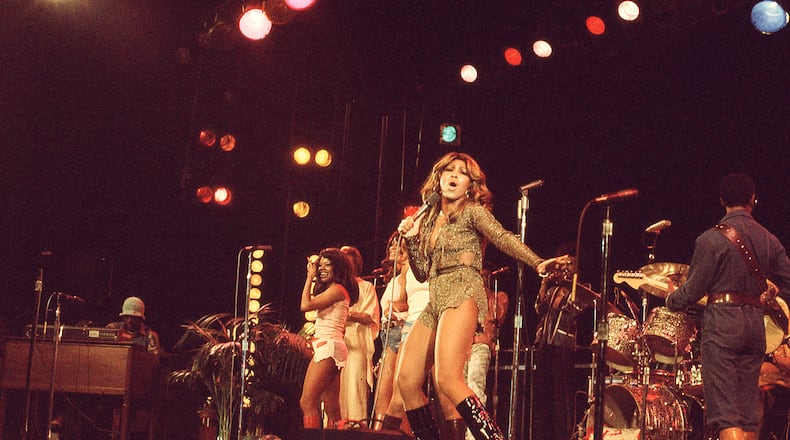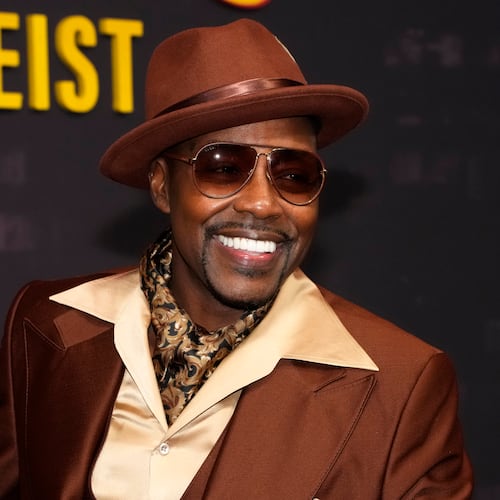It only needs one word: “Tina.”
The new documentary about the hardscrabble life of one of music’s most vaunted superstars — Tina Turner — is a blazing dive into the seesawing success and horrors of her life with the abusive Ike Turner, her unlikely — yet spectacular — return as a middle-aged rock strutter in the ’80s and her current state of retirement in Europe with longtime love Erwin Bach.
Dan Lindsay and TJ Martin, the Oscar-winning directors behind “Undefeated” and “LA 92,” teamed again to showcase Turner’s extraordinary life in the film, which debuts on HBO at 8 p.m. March 27 (it hits on demand March 28).
Even fans familiar with her story — one both disturbing soap opera and resounding triumph — from her 1986 autobiography with Kurt Loder, “I, Tina,” or the acclaimed 1993 film “What’s Love Got To Do With It,” named for her 1984 Grammy-winning single, will be riveted. Likewise, anyone questioning the validity of her nomination into the Rock & Roll Hall of Fame as a solo artist this year will be convinced of her dominance.
Credit: Courtesy HBO
Credit: Courtesy HBO
Precious early footage of Turner, her arms both graceful and feral as they tangle in the air, as well as her performance of “I Can’t Stand the Rain” in front of 186,000 people in Rio during her late-’80s “Break Every Rule” world tour, are moments that show the sweat and determination.
Interviews with Loder, Angela Bassett (who portrayed her in “What’s Love…”), Katori Hall (the book writer for the Broadway smash “Tina – The Tina Turner Musical”) and writer Carl Arrington, who first shared Turner’s distressing story in an early-’80s People magazine feature, add context, while a 2019 interview with Turner, 81, is the core.
In a recent conversation, Lindsay and Martin shared how they wanted the film to tell Turner’s story from her point of view and what it was like to spend time with the icon and Bach at their majestic Swiss home. In the process, they reminded us why “Tina” stands alone.
Q: You guys have worked together for almost 15 years and crafted documentaries on a range of topics. Why was Tina’s story one that you wanted to tell?
A: (Martin) A lot of questions came to mind (after we were asked if we’d be interested in directing), like, are two men the best people to direct this? We weren’t huge Tina fans, but of course, we respected her immensely. We thought about it and read “I, Tina,” and a couple of things stuck out. The time period when she left Ike and was in Vegas doing the cabaret act; the fact that it was seven years of her life that was not part of the narrative that people understand about Tina Turner. Her resilience, how she got to be the icon we all love. Most music documentaries are trying to find a story and leveraging the success of the music, and in this case, we were like, this is a proper movie, and we have the ability to tell a once-in-a-lifetime narrative of someone who is a singer.
Credit: Dave Hogan
Credit: Dave Hogan
Q: Hers is a fairly well-known story, especially with the movie (”What’s Love Got to Do With It”) and her books. What did you want to bring viewers that might have them admit, I thought I knew her history, but maybe not quite so much?
A: (Lindsay) As we started asking people younger than us — in their 20s and 30s — we were surprised to find out they didn’t know the story, and there is a whole new generation of people who would be an audience. There’s a bit of telling of it for the uninitiated. We discovered in early conversations with Tina that her relationship with her own story and the public identity of Tina Turner is a very complicated relationship. Tina is often rightly held up as someone who overcame trauma and is a symbol of strength and resilience. But a discovery for us was that we often forget that because she got away from that trauma and abuse, it doesn’t mean it went away. That choice to survive is a choice she’s making every day, even now in her 80s. So we said, let’s explore Tina through her point of view.
Q: What was it like being at her property in Switzerland? It looked pretty grand.
A: (Martin) Grand is an appropriate word! Tina did all of the decorating, and she and Erwin take a lot of pride in that. It’s big, but because Tina herself is legit down-to-earth and warm and inviting, you immediately feel very comfortable there. Home is a big deal to her, and she’s been trying to find a place she resonates with, and this particular place in Zurich — this castle in Zurich — it is a place where she finds a lot of peace and comfort in this stage of her life and you can feel that.
Credit: ARNAL
Credit: ARNAL
Q: She seemed pretty sanguine in the 2019 interview. Did you get the sense that she’s really at peace with her past now?
A: (Martin) Yes and no. I think the reason we took the point of view of the film is to underscore this idea that she’s processing. Even if someone acknowledges her past, even that acceptance, the healing emotionally, is something that’s a journey, and I think she found a place where she has a peaceful space for that healing. I think she has some good days and bad days. One of the big takeaways from Tina is the strength and resilience and also how that woman has worked so hard for six-plus decades as a performer. I think she’s at a place where she finally admitted to herself that she’s earned the opportunity to relax.
Q: She always threw herself into her live shows so deeply. I loved those live shots of her with the sweat just dripping down.
A: (Lindsay) That was important to Tina, that we lean into (showing her sweat). She embraces that part of it. She was like, I never had a towel on stage. She wanted to show the work.
Q: You have footage of her at the Venice Film Festival saying she didn’t watch “What’s Love Got to Do With It” because it was too difficult to relive. Has she seen the finished version of the documentary?
A: (Lindsay) Yes, she has seen the film. It was during quarantine, so we would have ideally gone over to Europe to show her, but we got a theater set up so she could see it, and we were anxious about it. Any time we make a film, we want the people we’re making it about to feel like we got it right. And there was anxiety that we were going to do the same thing to her that other people have. But ultimately she wanted to see it. Our producer said she was beaming and said, ‘You guys captured it!’ To me, it hints at the idea that there is some acceptance that this is how it was.
Q: I am curious why there was no mention of the various health issues she’s had this past decade?
A: (Martin) As with all films, there are multiple iterations. We did have some scenes that leaned in on her health issues, and love is a major theme in this film, and that Erwin gave her one of his kidneys (fits into that). It was in line with some of the major themes of the film. But then it started getting out of the world of the trajectory of the film, which is still a biopic through the lens of Tina and her relationship with what became the saga and legend of Tina…Every chapter of Tina’s life could be its own film. It’s like, what lane are you going to choose?
Q: Erwin says at the end that this film and the Broadway show is Tina’s farewell, and given her age, I think we know that’s probably true. Did you get that sense as well?
A: (Lindsay) Yeah, I think that became evident when we did the interview with her. She expressed to us that this was kind of it. I do feel pretty confident that she has worked her whole life and this and the musical are pieces that can exist without her having to get onstage.
(Martin) We were filming with her a couple of days before going to the Broadway premiere, and she did reaffirm the sentiment of feeling nervous about the event because she takes retirement very seriously and that includes the stage and the press and the mirror that has become Tina Turner. It was evident that she was exhausted from playing the role of Tina Turner, but she was deeply appreciative of the love and celebration of her story. It felt in that moment that this could be her opportunity to bow out and bow out slowly. That said, it is Tina Turner, and you never know what she might do.
About the Author
Keep Reading
The Latest
Featured







